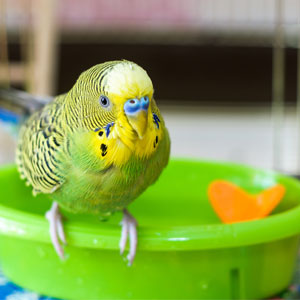
My First Bird
How Do I Care for My New Bird?
You've got the bird, a cage and some nutritious food and treats. So now what? Just like humans, dogs and most other pets, birds require specialized and regular grooming.If a bird is healthy, he will keep his feathers in good shape by frequent preening; however, your feathered friend will need your help with other necessary grooming tasks.
Nail Trimming
Before it's even time for your bird's nails to be trimmed you can be preparing and gearing up for this necessary grooming task. When playing with your bird, handle his toes as part of play. If your bird is a bit skittish at first to the idea of you touching his toes try a "high five" or "shake hands" with a gentle tap on the toe to help break the ice. Keep doing this as part of your regular play.When your bird's nails become sharp and uncomfortable for you to handle, it's most likely time to give your bird a nail trim. If in the back of your mind you've been dreading nail trim time, don't worry. The first step is to relax and make it fun for both you and your bird.
You can use a human nail trimmer for small birds or a bird scissors or guillotine type tool for larger birds. It can help to leave the scissors, clipper or trimming tool out where your bird can see it. Let your bird explore the trimming tool and you can even trim your own nail a bit so he can see what is going to happen. Talk to your bird and explain what you are doing. It's also a good idea to keep Kwik Stop® Styptic Powder on hand to stop bleeding in case you cut the vein inside the nail.
Proper length of nails depends on the size of the bird. Larger birds generally need longer nails. Have a trained groomer or veterinarian do the nail trim the first couple of times so you can see the correct length for your pet.
If your bird isn't a fan of getting his nails trimmed, try clipping just one nail a night for a week and repeat this once a month. This way it's a quick, regular occurrence and not a big deal so they can quickly get back to destroying that new toy you just got them.
The type of perches you provide your bird can help to extend the time between nail trims. A rough textured grooming perch such as the Sand Walk Orthopedic Perch can help safely keep nails trimmed without your bird even realizing it! This type of perch should be placed somewhere where it can be used often, but not as the primary perch.
Singin' in the Shower aka Bath Time!
When it comes to bath time most birds enjoy daily bathing; however, it's best to follow your bird's lead as to how often he wants a bath.It's best to use plain water when it comes to bird bathing. Some birds like to bathe in a dish or bowl while others prefer bathing under the faucet or even in the shower. You won't be the only one singing in the shower anymore!
If the bird resists any form of bathing, a daily misting with clean water will help encourage healthy grooming. A squirt bottle such as the Double Mist Trigger Sprayer is a great way to dampen your bird's feathers; just make sure your spray bottle is set to mist and not spray! If your bird doesn't like being misted directly, spray up so the water falls like rain. Another idea is to offer your bird a large handful of wet lettuce leaves to play with and enjoy. If his feathers become unusually soiled you can use mild baby shampoo followed by careful rinsing.
Wing Care
Your bird's wings should be examined monthly. It can help to designate a day each month as "Wing Checking Day." It's a good idea to get your bird accustomed to allowing you to touch and lift his wing feathers. Some birds like having the underside of their wings scratched and will lift a wing up so you can easily do so. To train your bird to lift his wing on command, applaud and use a consistent phrase such as "eagle boy" or "big bird!" whenever he spreads his wings. Continue to do this until your bird spreads his wings on cue.To Trim Wings or Not?
Whether or not to clip or trim your bird's wings is a personal decision that you have to make.When you trim a bird's wing feathers, his long flight feathers are cut short. These long flight feathers will grow long again at the next molt, which generally happens every six months to a year. Smaller caged birds such as canaries and other finches don't need to have their wings trimmed.
Here are a list of the pros and cons of wing trimming to help you decide what is best for you and your bird:
Pros
- It serves as a safety measure to ensure your feathered friend doesn't make an attempt to escape and fly out the front door or an open window. If a wing feather-trimmed bird does get out a door or window, chances are it cannot go far, making it easier for you to catch and bring back home.
- Birds with trimmed feathers are generally easier to train since they are easier to catch and count on you more to get around.
- Wing feather trimming slows a bird down, making flying safer for a bird inside the house. Windows, ceiling fans, mirrors and bodies of water, such as the kitchen sink, are dangerous; for example, you don't want your pet bird flying full speed into a big picture window.
- If you have a dog, cat or any other potential bird predator in the house, not being able to fly could put your bird in danger of not being able to escape if they are being chased by other household pets.
- Wing trimming denies the opportunity for free flight. Companion birds are natural athletes and are built to fly long distances. If you leave your pet bird flighted, he'll get good exercise and he'll experience a more natural flying experience. Just remember, if allowing your bird a free flight experience, make sure the area is "bird proofed" ahead of time to prevent injury.
If you want to give your bird some flight but slow him down a bit, consider trimming only a couple of the flight feathers. You can trim some of the feathers, but leave them longer than normal to allow gliding and limited but slowed flight.
If you do decide to go ahead with wing trimming, familiarize yourself with the proper wing trim technique for your bird before trimming your bird's wing feathers yourself. Know how to recognize and treat blood feathers and keep Kwik Stop® Styptic Powder on hand just in case a blood feather is clipped. It's recommended to have an avian veterinarian or an experienced groomer show you the proper wing feather length and trimming techniques before you attempt wing trimming for the first time.
Beak Trimming
Beak trimming should only be done by a trained veterinary professional, since damage can occur to the underlying tissue if too much grinding is done.If you notice your bird's beak becomes flaky, that can be a normal part of growth and aging. If your feathered friend doesn't chew and play with toys with enough force to adequately wear down his beak, his beak can become too long or develop abnormal flaky areas. If you notice this happening it's a good idea to take your bird to see his avian veterinarian.
Cuttlebones are essential to a bird's beak health. They are all natural and provide calcium and minerals while also helping to keep your bird's beak trimmed.
Towel Conditioning
Whether you groom your bird yourself or have a trained professional get the job done, it's a good idea to get your pet bird used to being handled in a towel. Using a towel can help you groom gently and safely, while reducing tension during regular vet visits. It can also save your bird's life in an emergency when you need to quickly pick-up and go.For successful towel conditioning follow these simple steps:
- Choose a solid-colored towel. Towels with loud patterns or startling colors may frighten your bird. Also, a velour-type towel is recommended since it is less likely to snag toenails than a terry loop towel.
- Lay the towel on your bed and let your bird play on it.
- Get your feathered friend onto the towel and peak his curiosity. Try scattering a few toys on the towel. Go slowly if your bird is reluctant. It may take a day or two for them to feel comfortable near the towel. Leave the towel near his cage so he can explore when he feels comfortable.
- Once your bird is comfortable standing on the towel, raise both ends and gently encircle your bird in it. Praise, enthusiasm, encouragement and paying attention to your fid's comfort level are key.
- Bring the towel up, over and around your bird. Gently encircle his head or neck in the towel, and make sure the bird's feet and body are supported. Talk calmly.
- Do not constrict your bird's chest. He needs to be able to expand his chest in order to breathe.
- Try to use the same towel each time you go to the vet or groomer. This gives your bird a soothing reminder of home.
Whenever you need to towel your bird, be calm, friendly and always approach from the front. Never try to fool your bird or sneak up from behind.
Leg Bands
Your bird's leg band can be removed if you want. Older open style bands are more dangerous and should be removed. Closed bands, a complete ring, rarely cause injury, but should be checked regularly for dirt or wounds underneath the band or swelling above or below the band.If You Aren't Comfortable... Ask for Help!
With any of your bird's grooming needs, if you aren't comfortable don't be afraid to ask for help. As soon as a new bird joins your family, you should schedule your first appointment with an avian veterinarian. That first visit would be a great time to ask all your grooming and bird care questions and have them show you their grooming tips and tricks.Now it's time to ask yourself "What Should I Feed My New Bird?"
Sources
Association of Avian VeterinariansBirds For Dummies by Gina Spadafori and Brian L. Speer
Discover More!
How to Clip Bird Wings (Video)How to Trim Bird Nails (Video)
Return to Bird Articles


